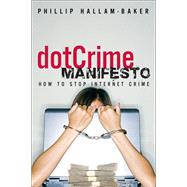
Dr. Phillip Hallam-Baker has been at the center of the development of the World Wide Web, electronic commerce, and Internet security for more than a decade. A member of the CERN team that created the original Web specifications, his list of design credits has few rivals and includes substantial contributions to the design of HTTP, the core protocol of the World Wide Web.
A frequent speaker at international conferences with more than 100 appearances over the past four years and numerous media interviews, Hallam-Baker is known for his passionate advocacy of what he calls technology for real people. His mission is to democratize technology, making technology serve the needs of the ordinary person rather than interest technologists or an artificial business model. The dotCrime Manifesto serves this mission by reaching out beyond the field of network security specialists to provide a firsthand, accessible account of the measures needed to control Internet crime.
Dr. Hallam-Baker was also responsible for setting up the first-ever political Web site on the World Wide Web and worked with the Clinton-Gore ’92 Internet campaign, correctly predicting that the Web would change the future of political communication, a prediction that led to the creation of the Clinton Presidential Web site, whitehouse.gov. While at the MIT Laboratory for Artificial Intelligence, Dr. Hallam-Baker worked on developing a security plan to allow deployment of the groundbreaking Internet publications system at the executive office of the president.
VeriSign Inc. was founded in 1995 to provide a trust infrastructure for the Internet that would allow people to buy and sell over the Web without worrying that a criminal might be able to steal their credit card number. This trust infrastructure was the key technology that allowed the development of online retail stores and banks. Dr. Hallam-Baker joined VeriSign in 1998 and became its first principal scientist in 2000. His first commission as principal scientist was to design a second-generation trust infrastructure for the Internet. This research work led to the design of XML Key Management Specification (XKMS), a protocol that reduces the number of lines of code necessary to connect to a trust infrastructure from more than a quarter of a million to less than two thousand. This research was also a major influence on the development of the Security Assertion Markup Language (SAML) protocol, which Dr. Hallam-Baker also edited. Both XKMS and SAML have been adopted as industry standards, and SAML was chosen by the Liberty Alliance as its key infrastructure protocol.
Since 2002, Dr. Hallam-Baker has increasingly focused on the problem of how to stop Internet crime. He played a leading role in the fight against spam and was one of the first researchers to argue for the authentication-based approach to spam control that has since become the Industry standard. In 2004, Dr. Hallam-Baker testified at the Federal Trade Commission workshop on authentication-based approaches to stopping spam.
Dr. Hallam-Baker holds a degree in electronic engineering from Southampton University and a doctorate in computer science from the Nuclear Physics Lab at Oxford University. He has worked at internationally respected research institutions such as DESY, CERN (as a European Union Fellow), and MIT. He is a member of the Oxford Union Society and a Fellow of the British Computer Society.
Preface xix
Acknowledgments xxiv
About the Author xxviii
Chapter 1: Motive 1
Chapter 2: Famous for Fifteen Minutes 37
Chapter 3: Learning from Mistakes 51
Chapter 4: Making Change Happen 81
Chapter 5: Design for Deployment 107
Chapter 6: Spam Whack-a-Mole 119
Chapter 7: Stopping Spam 135
Chapter 8: Stopping Phishing 155
Chapter 9: Stopping Botnets 175
Chapter 10: Cryptography 199
Chapter 11: Establishing Trust 215
Chapter 12: Secure Transport 227
Chapter 13: Secure Messaging 251
Chapter 14: Secure Identity 277
Chapter 15: Secure Names 311
Chapter 16: Secure Networks 323
Chapter 17: Secure Platforms 343
Chapter 18: Law 355
Chapter 19: The dotCrime Manifesto 377
Further Reading 383
References 387
Index 395
The New copy of this book will include any supplemental materials advertised. Please check the title of the book to determine if it should include any access cards, study guides, lab manuals, CDs, etc.
The Used, Rental and eBook copies of this book are not guaranteed to include any supplemental materials. Typically, only the book itself is included. This is true even if the title states it includes any access cards, study guides, lab manuals, CDs, etc.